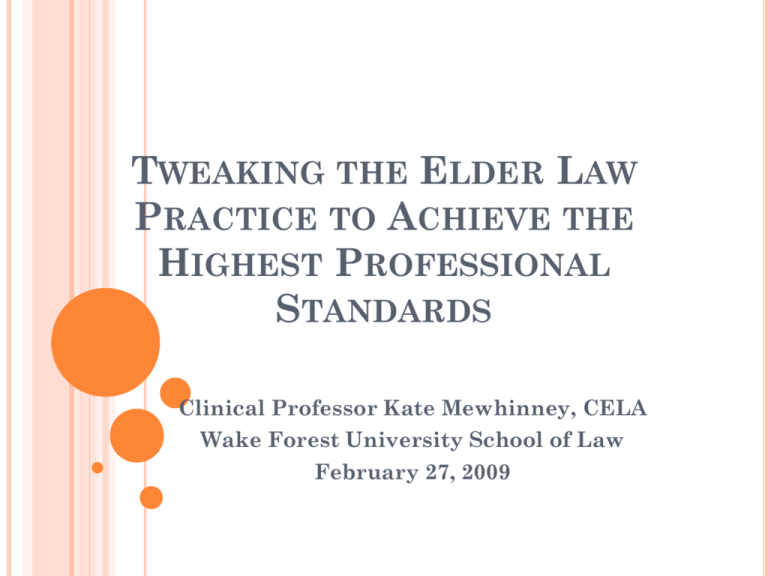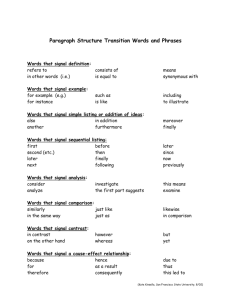
TWEAKING THE ELDER LAW
PRACTICE TO ACHIEVE THE
HIGHEST PROFESSIONAL
STANDARDS
Clinical Professor Kate Mewhinney, CELA
Wake Forest University School of Law
February 27, 2009
Kate Mewhinney, CELA
These materials were part of a Continuing
Legal Education program of the North
Carolina Bar Association Foundation.
They are reprinted with the express
permission of the North Carolina Bar
Association Foundation. All rights
reserved.
ASPIRATIONAL STANDARDS
Drafting committee of experienced elder law
attorneys, including A. Frank Johns of
Greensboro, a former NAELA President.
Non-binding recommendations.
Reviewed from various perspectives in the
NAELA Journal, Vol. II, No. 1 (2006).
Kate Mewhinney, CELA
Adopted in 2005 by the National Academy of
Elder Law Attorneys (NAELA).
The NAELA Standards and other elder
law ethics resources, such as the ACTEC
and opinions, are assembled on the website of
The Elder Law Clinic of Wake Forest
University School of Law in the Resources
Section.
www.law.wfu.edu/eclinic
Kate Mewhinney, CELA
Commentaries and pertinent NC ethics rules
TOPICS COVERED BY NAELA
ASPIRATIONAL STANDARDS
Kate Mewhinney, CELA
A - Client Identification
B - Potential Conflict of Interest
C - Confidentiality
D - Competent Legal Representation
E - Client Capacity
F- Communication and Advocacy
G - Marketing
H - Ancillary Services
I - Public Service
OUR PLAN FOR THE HOUR
Review
the “Standards” – esp. A to E.
Go
NC ethics rules/ opinions.
over a few hypotheticals.
Consider
some practical steps to
implement these standards.
Kate Mewhinney, CELA
Reference
STD. A – CLIENT IDENTIFICATION
identify who the client is
at the earliest possible stage and
communicate that information to the
persons immediately involved.
Kate Mewhinney, CELA
Gather all information and take all steps
necessary to:
If you determine that it is clearly not in
the best interest of the client to meet
privately with the client, you take other
steps to ensure that the client’s wishes are
identified and respected.
Std. A – Client Identification
Kate Mewhinney, CELA
Meet with the identified prospective or
actual client in private at the earliest
possible stage so that the client’s capacity
and voice can be engaged unencumbered.
Oversee the execution of documents
individual only after establishing a
attorney-client relationship with the
individual.
Std. A – Client Identification
Kate Mewhinney, CELA
that directly affect the interests of an
HYPO #1
Kate Mewhinney, CELA
Huey, Dewey, & Louie
make an appointment
with you to discuss
their Uncle Donald.
They share that he has
begun to show signs of
dementia and inquire
about a Durable Power
of Attorney.
Q #1: WHO IS YOUR CLIENT?
Nephews – they’re the ones in my office
and to whom I’m giving advice.
B.
Uncle Donald – he’s the one we’re talking
about and who will benefit from the
advice.
C.
Grandpa Walt – he’s the one who is really
in charge of Donald’s financial affairs.
D. No one – the nephews are all minors.
Kate Mewhinney, CELA
A.
Uncle Donald is the Client!
A lawyer may not prepare a power of attorney for
the benefit of the principal at the request of
consulting with, exercising independent
professional judgment on behalf of, and obtaining
consent from the principal.
[2003 FEO-7, available on the NC State Bar
website or at http://tinyurl.com/8qwdo9]
N.C. Ethics Opinion relevant to Std. A
Kate Mewhinney, CELA
another individual or third-party payer without
THE
Determining who is the client and meeting
privately isn’t always easy.
It is necessary to identify the client so you know
whose interests are being addressed.
It clarifies to whom you owe a duty of
competence, loyalty, and confidentiality.
It clarifies what steps can and cannot be taken,
if the client is not present at initial interview.
Kate Mewhinney, CELA
COMMENTS TO STD. A
Consider sending a copy of the ABA’s
“Understanding the Four C’s of Elder Law
Ethics” to the person who made the
appointment. Also have it in your lobby and on
your website. A sample is in your materials.
For copies, contact Bullockt@staff.abanet.org or
print it from http://tinyurl.com/9asxq7.
Comments to Std. A
Kate Mewhinney, CELA
Consider an intake form or staff training to
first ask “For whom or for whose interests are
legal services requested?”
If it is clearly not in client’s best interest to meet
privately with you:
Explain benefits of a private meeting (e.g.,
documents and decisions less likely to be the
subject of a challenge).
Note indications of discomfort by the client or
influence by relatives.
Note the content and tenor of comments, how
supportive or dominating the relatives are.
Comments to Std. A
Kate Mewhinney, CELA
Note how consistent or inconsistent the client’s
stated objectives are with prior wishes
evidenced by estate planning documents or
other expressions of intent.
Nevertheless, should meet at least once
with the client, alone, before the end of
representation.
[Learn the elements of an “undue influence”
claim and consider the ramifications of your
clients, you and your staff being subpoenaed in
a future challenge to your client’s actions. KM]
Comments to Std. A
Kate Mewhinney, CELA
EVEN IN THE “CLOSEST” RELATIONSHIPS
YOU MUST PROTECT THE CLIENT.
Undue influence doesn’t require bad motives
and may be exerted by a person with the best of
motives.
See In re Will of Jones, 12/12/08, N.C. S.Ct.,
where the wife and the testator had been married
for 47 years. Ct. of App. is reversed; case sent
back for trial on issue of wife’s undue influence.
www.aoc.state.nc.us/www/public/sc/opinions/2008/pdf/037-081.pdf
Kate Mewhinney, CELA
Undue influence can exist in a loving, long-term
marriage.
STD A – CLIENT IDENTIFICATION AND
JOINT REPRESENTATION
When is “joint representation” appropriate
and how should it be handled?
NAELA Standards and criticisms of it
follow….
Kate Mewhinney, CELA
STD. A ON JOINT REPRESENTATION
A joint representation letter is especially
important if the clients have blended families.
Comments to Std. A
Kate Mewhinney, CELA
If joint representation is appropriate (see
Rule 1.7 and Std. B), give the clients a letter or
agreement providing for waiver of confidences.
Clarify that:
All information will be available to all joint
clients.
In the event of a conflict between joint clients,
the attorney must resign.
NAELA APPROACH TO JT REP CRITICIZED
The NAELA Stds A and B accept it quite broadly.
Others criticize this as a “feel good” approach
that works well for most cases but not for those
that go awry.
“An Estate Planner’s Perspective of the NAELA Aspirational Standards”
by Jeffery N. Pennell, Esq., NAELA Jl., supra, at 95.
Kate Mewhinney, CELA
Some attorneys favor a “family approach” or
“communitarian approach” to elder law
consultations.
No real mention of the relative merits of
the concurrent separate representation
alternative.
Clients won’t confide under a “share all
secrets” arrangement.
Pennell, supra, at 101-102.
Kate Mewhinney, CELA
“Blended family situations [are] when the
train wreck is most likely to occur! This
[NAELA Std. A3] deserves a careful,
critical, and mostly cynical evaluation.”
CRITIQUE BY THE AMERICAN COLLEGE OF
TRUST AND ESTATE COUNSEL (ACTEC)
Consider holding a separate interview with each
prospective client, which may allow the clients to
be more candid and, perhaps, reveal conflicts of
interest that would not otherwise be disclosed.
[“What We Learned by Comparing the ACTEC Commentaries to
NAELA’s Aspirational Standards,” Ottaway, C. and Bennett, C.,
NAELA Jl, supra, at 114.]
Kate Mewhinney, CELA
COMPARE
Versus
ACTEC Commentaries allow the attorney to:
withhold information,
share information, or
withdraw, as the lawyer deems best under
the circumstances.
Ibid, at 111-112.
Kate Mewhinney, CELA
Std A: Engagement letter should provide for
waiver of all confidences in joint representation.
However, the Comment says the letter should
also provide that in the event of a conflict
between joint clients, the attorney must resign.
A NORTH CAROLINA EXAMPLE:
THE ESTATE OF CHARLES KURALT
Kate Mewhinney, CELA
Did the N.Y. attorneys malpractice when they drafted
the burden-on-the-residue tax payment provision that
bankrupted the probate estate with the tax generated
did not know existed, to a beneficiary who they also
knew nothing about?
No? Because the attorneys did not know about the
paramour or about the Montana ranch?
WHY DID THEY NOT KNOW?
[Pennell, ibid.]
Kate Mewhinney, CELA
by a specific bequest of out-of-state realty the lawyers
Std A – Client Identification
Diminished Capacity
Kate Mewhinney, CELA
– and the Client With
NC RULES RELEVANT TO STANDARD A
When a client's capacity to make adequately
representation is diminished, … the lawyer
shall, as far as reasonably possible,
maintain a normal client-lawyer
relationship with the client. Rule 1.14(a).
See also Std. E – Client Capacity.
Kate Mewhinney, CELA
considered decisions in connection with a
Selected comments to N.C. Rule 1.14(a)
[2] The fact that a client suffers a disability
treat the client with attention and respect.
Even if the person has a legal representative,
the lawyer should as far as possible accord the
represented person the status of client,
particularly in maintaining communication.
N.C. Rule 1.14 and Std. A
Kate Mewhinney, CELA
does not diminish the lawyer's obligation to
[3] The client may wish to have family
members or other persons participate in
discussions with the lawyer. ….
foremost and, except for protective action
authorized under paragraph (b), must to look
to the client, and not family members, to make
decisions on the client's behalf.
N.C. Rule 1.14 and Std. A
Kate Mewhinney, CELA
[T]he lawyer must keep the client's interests
Once you’ve identified the client, then what?
See N.C. Rules 4.3 and 1.18.
Kate Mewhinney, CELA
THE FLIP SIDE OF WHO’S THE CLIENT:
WHO’S NOT THE CLIENT?
DEALING WITH UNREPRESENTED
PERSONS – RULE 4.3
Do not state or imply that you are uninterested.
the unrepresented person misunderstands your
role in the matter, you shall make reasonable
efforts to correct the misunderstanding.
Comment: Unrepresented people might assume
that the lawyer is a “disinterested authority on
the law.”
Kate Mewhinney, CELA
When you know or reasonably should know that
DUTIES TO PROSPECTIVE CLIENT
Issue: What if the older person’s relatives
bringing him/her, and it later turns out the
family really isn’t in complete agreement?
Of course, try to avoid this by having a
policy of asking that the older person come in
first!
N.C. Rules relevant to Std. A
Kate Mewhinney, CELA
come to see you about that person, without
If the agreement expressly so provides, the
prospective client may also consent to the
lawyer’s subsequent use of information
received from the prospective client.”
Comment 5 to N.C. Rule 1.18, “Duties to
Prospective Client.”
Kate Mewhinney, CELA
“A lawyer may condition conversations with a
prospective client on the person’s informed
consent that no information disclosed during
the consultation will prohibit the lawyer from
representing a different client in the matter.
[….]
NC ALLOWS FOR “MIRANDA WARNING”
Ethics Opinion 2003 FEO-7, Inquiry #4
(emphasis added)
Kate Mewhinney, CELA
I, [Daughter], understand that Attorney does not
represent me regarding issues that concern my
mother. I understand that Attorney may be
representing my mother after Attorney meets
with her. I also understand that whatever I say
to Attorney may be used against my
interests by Attorney in her representation of
my mother. I understand I could hire my own
lawyer and I have chosen not to do so. I have
read this document and understand its contents.
PRACTICE TIPS
1.
3.
4.
Kate Mewhinney, CELA
2.
Identify the client –
out loud,
in writing, and
to all involved parties
Meet alone with the client
Don’t imply to relatives that you’re
uninterested.
Consider the “Miranda warning”
when the older person’s relatives
come in to see you first.
STD. B– POTENTIAL CONFLICT OF INTEREST
Analysis:
Review of basic NC rule on conflicts.
2.
What do the NAELA Aspirational Standards
recommend?
3.
What do the NC Rules and NAELA Stds say
about 3rd party payment of fees, if you even
allow that practice?
Kate Mewhinney, CELA
1.
N.C. RULES RELEVANT TO STD. B
Rule 1.7 provides that
(1) the lawyer reasonably believes the
representation will not adversely affect the
relationship with the other client; and
(2) each client consents after consultation.
…cont’d…
Kate Mewhinney, CELA
(a) A lawyer shall not represent a client if the
representation of that client will be directly
adverse to another client, unless:
(1) the lawyer reasonably believes the
representation will not be adversely affected;
and
(2) the client consents after consultation.
N.C. Rules relevant to Std. B regarding Conflicts
Kate Mewhinney, CELA
(b) A lawyer shall not represent a client if the
representation of that client may be materially
limited by the lawyer’s responsibility to another
client or to a third person, or by the lawyer’s own
interests, unless:
the implications of the common
representation and
the advantages and
risks involved (including
foreseeable conflicts of interest).
Std. B – Potential Conflicts of Interest
Kate Mewhinney, CELA
When representation of multiple
clients in a single matter is undertaken
the consultation shall include
explanation of:
TRANSLATING THIS STUFF TO THE
INTERGENERATIONAL CLIENT GROUP
I have yet to find an example of this.
How do you explain this – the pros and cons,
implications and risks, predictions and potential
costs?
Is it realistic to say that an older client has fully
understood and freely consented to joint
representation, if it is difficult for us to explain
these issues?
What if the parent is at all impaired, depressed,
or dependent on the relatives who brought them
to you?
Kate Mewhinney, CELA
STD. B – POTENTIAL CONFLICTS OF
INTEREST
If representing multiple family members,
clients and whether the representation is
Joint (i.e., confidences are shared) or
Separate.
These situations can easily produce
misunderstandings among family members,
so education is important.
Kate Mewhinney, CELA
ensure that they understand who are the
Treat family members who are not
clients as unrepresented persons but
representation so long as it is:
consistent with the client’s wishes
and values, and
the client consents to the involvement.
NAELA Std B regarding Conflicts
Kate Mewhinney, CELA
accord them involvement in the client’s
by a 3rd party only after….
3rd party payment of fees. Rule 1.8(f), restated
in NAELA Standard B.
Kate Mewhinney, CELA
Accept payment of client fees
determining that this won’t influence
your independent judgment on
informing the client who consents to
the payment by a third party, and
ensuring that the parties understand
and agree to the ethical ground rules
for 3rd party payment, which are….
Kate Mewhinney, CELA
behalf of the client,
…..
• Independence of judgment by
the attorney, &
• Confidentiality.
3rd party payment of fees, cont’d. Rule 1.8(f)/ Std. B.
Kate Mewhinney, CELA
• Non-interference by the payor,
Or, just say…..
Kate Mewhinney, CELA
NO!
HYPO #3
She is currently in her fourth
marriage.
Her husband does not join in the
consultation, but she states that
he will come to the next
meeting.
Kate Mewhinney, CELA
Zsa Zsa from Wysteria Lane
meets with you for estate
planning.
Q #3: CAN YOU REPRESENT BOTH?
B. Maybe; provided both parties understand
and consent.
C. No; this is unwise, especially in multiple
marriage situation.
D. Never represent a housewife from Wysteria
Lane.
Kate Mewhinney, CELA
A. Yes; joint representation of married
spouses is permitted, especially in estate
planning.
PRACTICE TIPS FOR WHEN JOINT
REPRESENTATION IS AUTHORIZED
Review the rule on conflicts of interest.
2.
Obtain informed consent of both/all parties.
3.
Execute a joint representation agreement, or
confirm the agreement in writing, if
appropriate.
Kate Mewhinney, CELA
1.
STD. C - CONFIDENTIALITY
Carefully explain the obligation of
parties as early as possible in the
representation to avoid misunderstanding,
and to ascertain and respect the client’s
wishes regarding the disclosure of
confidential information.
The release of confidentiality should be
placed in writing.
Kate Mewhinney, CELA
confidentiality to the client and involved
N.C. RULES RELEVANT TO STD. C DUTY OF CONFIDENTIALITY
acquired during the professional relationship
with a client unless the client gives informed
consent, the disclosure is impliedly authorized in
order to carry out the representation or the
disclosure is permitted by paragraph (b).
N.C. Rule 1.6(a) - excerpt
Kate Mewhinney, CELA
A lawyer shall not reveal information
PRACTICE TIP ON CONFIDENTIALITY
Consider including this is engagement letters or
You indicated that this office could release any
information you provided me to [state name and
relationship of person(s); ex.: your daughter,
D.D. Jones], if I determine that this would be in
your best interests.
Reminds you to be explicit about disclosure issues.
Kate Mewhinney, CELA
retainer agreements:
STD. D –
COMPETENT LEGAL REPRESENTATION
Recognize the special range of client needs
and professional skills unique to the practice
of elder law and hold yourself out as an
“Elder Law Attorney” only after ensuring
your professional competence in handling
elder law and disability related matters.
Kate Mewhinney, CELA
Approach client matters in a holistic
manner, recognizing that legal
representation of clients often is enhanced
by involvement of other professionals,
support groups, and aging network
resources.
Practice tips:
Establish formal or informal
relationships with social workers,
psychologists and other elder care
professionals to best serve the client’s
legal needs.
Kate Mewhinney, CELA
Std. D – Competent Legal Representation
STD. E – CLIENT CAPACITY
Respect the client’s autonomy and right to
diminished capacity.
Develop and utilize appropriate skills and
processes for making and documenting
preliminary assessments of client capacity to
undertake the specific legal matters at hand.
Kate Mewhinney, CELA
confidentiality even with the onset of
Adapt the interview environment, timing of
meetings, communications and decision-making
processes to maximize the client’s capacity.
Take appropriate measures to protect the client
when you reasonably believe that the client has
diminished capacity, is at risk of substantial
physical, financial or other harm unless action is
taken, and cannot adequately act in the client’s
own interest.
Std. E cont’d. – Client Capacity
Kate Mewhinney, CELA
See earlier slides on N.C. Rule 1.14
in section on Standard A- Client
Identification.
Kate Mewhinney, CELA
on representing the impaired client,
Std. E cont’d. – Client Capacity
Kate Mewhinney, CELA
When taking appropriate measures to protect
the client:
Be guided by the wishes and values of the
client and the client’s best interests;
Seek to minimize the intrusion into the
client’s decision-making autonomy and
maximize the client’s capacity;
Respect the client’s family and social
connections; and
Consider a range of actions other than court
proceedings and adult protective services.
PRACTICE TIP – TELL CLIENTS WHAT YOU
WILL DO IF THEY BECOME INCAPACITATED.
On occasion, our clients become ill while
we are representing them. I am enclosing
a page that explains how we would handle
such a situation, if that was to happen to
you. Please let me know if you have
questions about it.
Kate Mewhinney, CELA
Consider informing clients of your policy, in
an engagement letter or retainer agreement.
For example:
WHAT IF YOU BECOME MENTALLY UNABLE
TO MANAGE YOUR AFFAIRS?
Suggested policy to share with clients – pg 1 of 2
Kate Mewhinney, CELA
This page explains our policy if we have serious
concerns about your mental capacity.
If we are still representing you, we will continue to do
so. We will take steps to protect your interests. We will
follow legal standards of practice and ethics rules. N.C.
ethics rules provide that, when a client cannot act in his
own interest, the lawyer may take appropriate action in
assessing the client’s capacity and considering protective
action. This could include seeking appointment of a
guardian.
I would only take actions that I reasonably believe to
be in your best interests and consistent with your
previously expressed wishes.
Suggested policy to share with clients- pg 2 of 2.
Kate Mewhinney, CELA
Unless you direct me otherwise in writing, you
authorize me:
(1) to communicate with your family, your
physicians and your other advisors and to give
them confidential (private) information that I
think is appropriate under the circumstances,
and
(2) to represent one or more members of your
family or other advisors acting in a fiduciary
relationship (which means a “trusted”
relationship) for you or your property.
However, I would not represent them in any
proceeding involving determination of your
capacity.
HYPO #2
The nephews share with
you that Donald has midstage Alzheimer’s, and they
need advice about his longterm care options.
Kate Mewhinney, CELA
Huey, Dewey, and Louie
meet with you to discuss
their Uncle Donald. They
present to you a validlyexecuted DPOA, naming
Huey as principal agent for
Donald.
Q #2: WHO IS YOUR CLIENT?
Nephews
B.
Donald
C.
Huey
D. Donald and Huey
Kate Mewhinney, CELA
A.
In representing a fiduciary for a person with
diminished capacity:
Be guided by the known wishes and best interests
Disclose otherwise confidential information, in the
event a conflict arises between the fiduciary and
the person with diminished capacity, if necessary
to avoid substantial harm to the interests of the
person with diminished capacity.
Std. E cont’d. – Client Capacity
Kate Mewhinney, CELA
of the person with diminished capacity, and
STD. F – COMMUNICATION AND ADVOCACY
Work to minimize barriers to effective
persons or persons with disabilities.
Maintain direct communication with the client,
even when the client chooses to involve others in
the process, and especially when significant
decisions are to be made.
Kate Mewhinney, CELA
communication with and representation of older
STD. G - MARKETING
Consider marketing to educate public and
Only market truthful communications.
No false or misleading communication at
presentations or seminars. (e.g., no message that
“one size fits all” or exaggeration of benefits of a
course of action)
Kate Mewhinney, CELA
promote profession of elder law.
Reasonable basis required to suggest superiority
over other attorneys.
reflects collective judgment of the organization and
disclose any relationship with the organization that
might materially affect the weight or credibility of
the endorsement.
No uninvited or phone solicitation of prospective
clients who may be vulnerable to undue influence.
Std. G – Marketing. Cont’d.
Kate Mewhinney, CELA
Use organizational endorsement only if truthfully
N.C. RULES & DEVELOPMENTS
RELATED TO STD. G
Board of Legal Specialization of N.C. State Bar has
www.nclawspecialists.gov/
Held in conjunction with the National Elder Law
Foundation, www.nelf.org.
An attorney who has been certified as a specialist by that
Board may so indicate in an advertisement in any way
that is not false, deceptive or misleading. RPC 43 – July
15, 1988.
Kate Mewhinney, CELA
authorized a certification in the field of elder law. See
TOP 10 PRACTICAL TIPS
Identify your client at outset of representation.
2.
Meet with the identified prospective or actual
elder client in private.
3.
Provide client with written engagement
contract.
4.
Explain obligation of confidentiality to client
and involved parties as early as possible.
5.
Approach client matters in a holistic manner.
Kate Mewhinney, CELA
1.
6.
Ensure adequate training and supervision of legal
and non-legal staff.
7.
Develop and use skills/processes for making and
capacity to undertake specific legal matters at hand.
8.
Advocate within the law courses of action chosen by
the client.
9.
No misleading or materially false information is
communicated in connection with seminars, etc.
10.
Ensure that ancillary services are licensed and meet
the client’s needs.
Kate Mewhinney, CELA
documenting preliminary assessments of client
Clinical Professor Kate Mewhinney
Kate Mewhinney, CELA
Thank you for your attention and
for striving to meet the highest ethical
standards for older clients and their
families.



![The mysterious Benedict society[1]](http://s2.studylib.net/store/data/005310565_1-e9948b5ddd1c202ee3a03036ea446d49-300x300.png)



